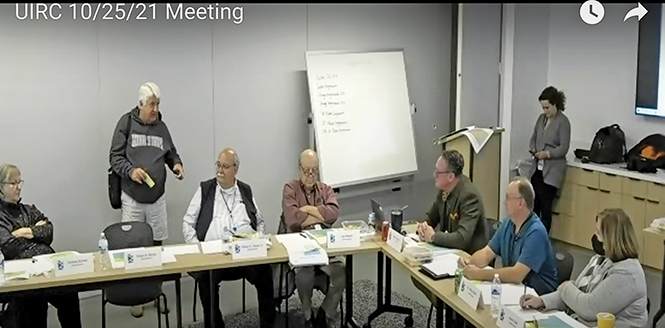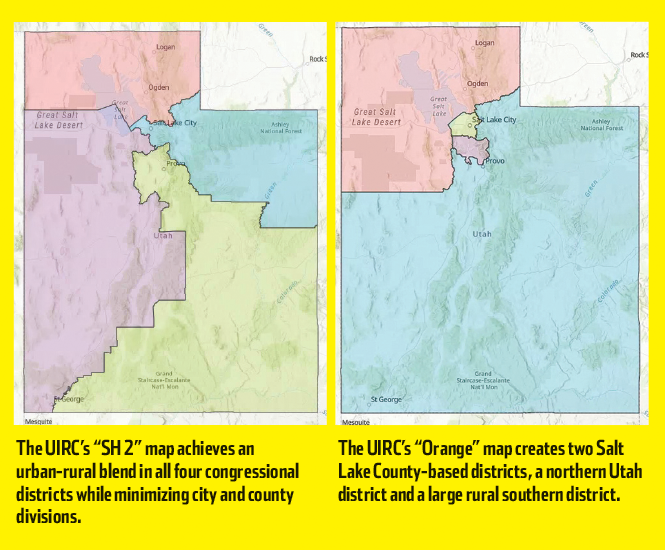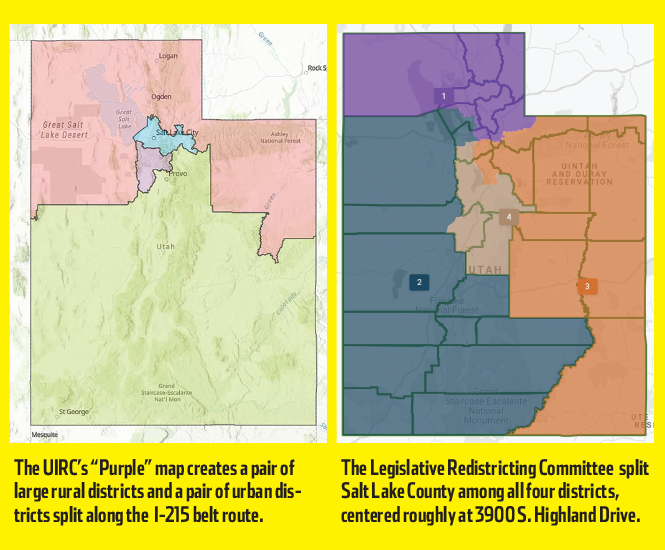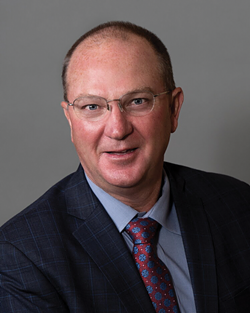
-
Cover design by Derek Carlisle
There was hope. There was cynicism. And now there’s reality.
The decennial task of redistricting is out of the people’s hands, and the Utah Legislature is now to determine how much gerrymandering it can get away with. But first, lawmakers had to deal with the 12 maps—three each for Utah’s congressional, state House, state Senate and Board of Education—created by the voter-backed Utah Independent Redistricting Commission (UIRC).
Because the UIRC is advisory only, its recommendations were always at risk of being scrapped. And the thin veneer of cooperation cracked last month with the theatrics of commissioner and former Congressman Rob Bishop. Clearly uncomfortable, Bishop was fidgeting at the UIRC’s final meeting, occasionally glancing at his phone while his partner, former Utah Supreme Court Justice Christine Durham, was madly shuffling through a sheaf of maps.
Bishop had had enough. He said he was frustrated. “As a group, we suck,” he said, complaining he’d been unhappy that the commission was a “metro-centric” group, made up largely of members from the Wasatch Front. Later, House Speaker Brad Wilson, R-Kaysville, would echo that sentiment, although it was legislative leadership that chose the commissioners, and Wilson himself who appointed Bishop to the panel.
“I can’t take it anymore,” Bishop said. “I’ll make it easier for you. I’m going to resign now.” With that, he got up, slung his backpack over his shoulder and left. While much has been made of his attire—casual shorts and a hoodie for the man once named the nation’s third-best-dressed congressman—Bishop has always done his own thing. And to set the record straight, he was not wearing flip-flops, as many observers claimed.
“I was wearing shoes. I haven’t worn socks in two years,” he later explained, because he pays attention to those things, and frankly, it’s part of his public image.
While Bishop’s exit from the voter-approved commission was sudden, it was also emblematic of the problems facing Utah as citizens and lawmakers face off over political representation. The biggest issue, as ever, is how to tackle the state’s urban-rural divide and determining who gets to have the loudest voice.
In Utah, both congressional and state legislative district boundaries are drawn by the state Legislature.But citizens—like those in many other states—took the issue to the voters and, in 2018, passed Proposition 4, the independent redistricting commission initiative, by a razor-thin majority. While the initiative succeeded, the law was later altered by the Legislature to bolster its sole, constitutional authority to draw the lines.
The Legislature didn’t like giving their power to the people and could have simply wiped out Prop 4 entirely. But lest such heavy-handedness raise the ire of the masses, they crafted a compromise that eliminated the Legislature’s requirement to explain its decisions and set up tandem redistricting committees that were destined to confuse and conflate the process.

- “I can’t take it anymore,” says former U.S. Rep. Rob Bishop, standing, as he resigns from the Utah Independent Redistricting Commission (UIRC) in late October.
Vote Them Out?
Bishop is nothing if not a team player—it just depends on the team. When he was Utah speaker of the house, Bishop maintained a moderate aspect. That’s what speakers are supposed to do, he said. Once out of that office, he was happy to show his more conservative colors, becoming a lobbyist for the National Rifle Association and Envirocare—because who doesn’t love nuclear waste?—and then calculating his odds to take the seat of retiring Congressman Jim Hansen.
Bishop said he accepted the redistricting commission seat reluctantly. “I was expecting something different, maybe a greater understanding of the state of Utah. … I didn’t think I was the smartest person in the room, but when I made a difference in Washington, I was.”
Redistricting is not an easy task—it spurs intense emotions and is grounded in the murky precepts of fair representation, one person-one vote, and what many people call democracy. Sen. Mike Lee, however, likes to remind voters that the United States is not a “rank” democracy, stupid, it’s a representative democracy. The distinction is that voters elect representatives to make decisions for them—with or without deference to majority opinion. If you don’t like what they do, politicians say, you can always vote them out.
“Vote them out doesn’t work,” said a visibly frustrated Susan Olson, a retired political science professor who spoke to the legislative redistricting committee at its Nov. 1 hearing. That was when the commission released its 12 maps to the legislative committee. The Capitol room was full. An overflow room was full. People were waiting online to send their final comments. And to a person, the message was for the Legislature to accept the months of work that led to the independent maps.
That acceptance is unlikely, as the legislative committee quickly rejected the independent recomendations and adopted its own, flagrantly gerrymanderd slate of maps on Monday. And with no time to waste, the full Legislature convened a special session the next day to consider its options. At press time, the special session was ongoing.
Reading the daily news or scanning the more than 2,000 comments to the UIRC highlight the deep distrust of the process—a process that was difficult, confusing and lacking a sense of the urgency it requires. Political observers say the public may not have fully understood the difference between the Utah Independent Redistricting Commission and the Legislative Redistricting Committee, both working simultaneously along parallel paths, holding public hearings around the state and amassing feedback.
Both panels aspired to work transparently, offering virtual as well as in-person access as they engaged with residents. But while the UIRC drew its maps in broad daylight, offering justifications and explanations for its decisions, voters have little insight into the thinking behind lawmakers’ maps, as they were drafted behind closed doors and evaluated by incumbents before their release to the public.
The independent commission was required to hold seven public hearings, but ultimately held 16. Representatives also participated in community events like the Jordan Stampede and the Provo Farmers Market. The legislative committee also held 16 hearings, sometimes changing a venue so as not to conflict with the commission.
Commissioners heard citizens talk about their communities and a need to be represented while the legislative committee often heard expressions of appreciation for elected officials. In fact, one participant told the legislative committee that he had drawn a map specifically to honor Rep. Chris Stewart by giving him Hill Air Force Base.
But as everyone listened and took notes, they struggled internally with two competing elements—communities of interest and the sticky rural-urban divide. Turns out, there is no legal definition in Utah of “communities of interest,” and yet that’s what got people talking. Voters, it seems, want to be represented by people like them, people who hold their same values and face their same problems—and by people who live in relative proximity.
And so, much of the feedback came from areas like the Salt Lake, Summit, Grand and Weber counties, where districts have traditionally been carved up and shared with far-flung areas that hold contradictory needs and desires. That irritated Bishop. That and people mispronouncing Duchesne and Tooele and some commissioners not knowing their Utah geography, he said.
“For the state of Utah to have clout in Washington, the congressional delegation has to have an understanding of urban and rural issues,” Bishop said. “It’s important that our congressional delegation has the ability to work together.”
Maybe, though, it’s less about the urban-rural mix than it is about the state’s liberal-conservative makeup.
Parts and Parcels
Kael Weston—a Democrat who in 2020 ran for Congress against Rep. Chris Stewart—took those concerns to heart and set out to become part of the fabric of Utah. To that end, he attended six of the legislative redistricting committee meetings from Clearfield to Richfield and tweeted about every move that was made along the way.
“Everyone talks about a listening tour, but you have to take the first step,” he said. “It’s more than drawing lines. It’s coming out of a very divisive time.”
The divide won’t be closing any time soon. Utah’s population is only 9% rural and has the ninth highest urban population in the nation at 90.6%, according to the Kem C. Gardner Policy Institute. That means that the state’s population is largely concentrated in urban areas—namely, the Wasatch Front.
“Here in Utah, we see marked social, political and policy divergence between areas of urban growth like Salt Lake and Utah counties, and rural areas of the state that are struggling to keep jobs and families in their communities,” notes a study from the Gardner Policy Institute.
The question becomes how to fairly represent those areas and whether having both rural and urban communities in one federal voting district gives rural residents a fighting chance or effectively snuffs out those urban voices.
When Bishop resigned, Speaker Wilson, who did not respond to a request for comment, said he understood the frustration because none of the commissioners were from rural Utah (Commissioner Lyle Hillyard, a former lawmaker, resides in Cache County). And in fact, it was legislative leadership and the governor who appointed the commissioners. It should also be noted that not one member of Utah’s congressional delegation lives in rural Utah. They don’t have to, despite lawmakers’ insistence that each district include rural constituencies.
Melding urban and rural is just not how the Founding Fathers envisioned voting districts, Linda Smith, a retired law professor, wrote in a recent op-ed. “Both the plain language of the Constitution and the framers’ intent are for senators to represent the state, and congresspeople to represent the people in their district—not the state as a whole or the interests of the entire state.”
The last redistricting effort in 2011 resulted in what people call the “pizza slice” approach to map-drawing, with the big side of the crust down in rural Utah. Urban Utah, and Salt Lake County in particular, got sliced up at the tips. It wasn’t pretty.
Stuart Hepworth, a now-23-year-old political science major, told the committee just how ugly it was and used former Rep. Jim Matheson as an example. For the 20 years after Utah gained its 3rd congressional district in 1981, the state had one district that was solely based in Salt Lake County and two in the rest of the state.
But in 2001, the Republican supermajority used its “full force” to gerrymander Matheson out, Hepworth said. In 2000, Matheson won by 38,000, but won by only 1,600 in 2002.
“This wasn’t an accident. It was a heinous gerrymander that failed only due to Matheson’s political talent,” Hepworth said. Hepworth then twisted the knife by quoting from two late GOP icons—Sen. Bob Bennett and Rep. Jim Hansen. Bennett, who lost his Senate seat during the Tea Party explosion in 2010, called Utah’s the worst gerrymander he’d ever seen. Hansen said it was a reason not to have the Legislature draw the lines.
By 2012, Matheson won by a mere 700 votes. He then opted to retire rather than seek another term.
“The tradition we have of urban-rural split was not founded on any noble principle. It was founded on the classic idea of ‘might makes right,'” Hepworth said. “It has been argued that the status quo of pinwheeling Democratic Salt Lake City increases its representation in Washington. Balderdash!”
Hepworth has attended meetings of both the UIRC and the legislative committee while drawing dozens of maps himself. The UIRC treated him with respect and, in fact, adopted one of his maps to present in their recommendations to the legislative committee. The legislative committee, however, was less welcoming to the young activist, shutting him down in its final hearing, and saying that he was “demeaning” the committee for something it had yet to do (and ultimately did).
Balancing Acts
How hard is it to draw a few maps, committee co-chair Sen. Scott Sandall, R-Tremonton, would joke. The answer is, “hard.” New political boundaries are based on numbers from the COVID-impacted and already-out-of-date 2020 Census, which may be updated later and could trigger lawsuits pushing for yet another round of political map-drawing.
“Under Utah law, congressional districts are allowed population deviations up to 1 percent, which would allow for the highest populated congressional district to contain 826,083 people and the smallest populated district in the state to contain 809,725 people,” according to the commission’s redistricting report. Mapmakers, it said, needed to find a balance between the Supreme Court mandate of one-person-one-vote and the desire to keep counties, cities, towns and communities together.
Both the UIRC and the legislative committee chose a mapping software called ESRI, through which the public could submit their own designs. But in one antithetical exchange, Sandall openly questioned whether UIRC had inappropriately used partisan data—as in how a map helps or hurts a particular party—by adopting Hepworth’s map, because it had been originally drawn on a program with partisan impact tools.
In fact, the UIRC was given partisan data only after it completed and approved its maps. Commissioners thought the Legislature might want to see it. And while Hepworth used third-party software, he said he didn’t use its partisan features. And the UIRC converted his map to ESRI before giving it to the committee.
The legislative committee, however, managed to note where every single incumbent lived on their maps—all but confirming they were drawn to prioritize candidate interests over that of cities, counties and communities.
The UIRC was charged with certain criteria, such as keeping districts relatively compact and contiguous, keeping communities of interest together, not favoring incumbents or parties and staying within accepted population deviations. In some cases, commissioners noted that jagged municipal boundaries lead to shapes on its maps that can appear inappropriately erratic, but are in fact respectful of existing communities.

A Thousand Cuts
Unconventional district shapes first gave rise to the word “gerrymander,” named after Massachusetts Gov. Elbridge Gerry. In 1812, he signed a bill creating a partisan district in the shape of a mythical salamander. Public interest groups have been fighting gerrymandering ever since, and while the U.S. Supreme Court ruled racial gerrymandering to be illegal, it has never found cause to overturn maps drawn overtly for partisan effect.
Attempts to mathematically define gerrymandering have so far failed to impress the high court, with its decisions instead stressing the need for political and legislative solutions to gerrymandering—aka: vote them out, if you can.
Enter Moon Duchin of Tufts University’s MGGG Redistricting Lab. MGGG stands for Metric Geometry and Gerrymandering Group. How wonky is that? “Our staff has expertise and interests spanning mathematics (geometry, topology, discrete math, dynamics), algorithms, software development, geography,STS (science, technology and society) and policy. We research data science interventions for civil rights,” Duchin said.
The UIRC’s lawyer retained Duchin and BYU professor Tyler Jarvis to help evaluate what the Commission came up with, and after an eye-crossing charts-and-graphs report, she gave it a thumbs up. The commission’s maps also received “A” grades nearly across the board—one map received a “B”—from the Princeton Gerrymandering Project, which then issued a memo critical of the Legislature’s designs.
Utah is far from the only state where lawmakers tend to serve their own interests. Recent years have seen a surge in lawsuits—some successful, others not—challenging lopsided political representation. In Texas, the Mexican American Legislative Caucus and Democrats are challenging U.S. House maps “that favor incumbents and decrease political representation for growing minority communities, even as Latinos drive much of the growth in the nation’s largest red state,” ABC reported.
Alabama has already approved maps projected to maintain its GOP supermajorities. And the Pew Charitable Trust notes that bipartisan commissions are giving Democrats headaches as those commissions work for political parity, deflating Democratic advantages in battleground areas while Republicans freely draw lines to benefit their party in red states.
And yet, advocates for fair elections say there is hope. “The commission succeeded beyond my wildest dreams, even with the resignation (of Bishop),” said Gigi Brandt, who has been observing Utah’s redistricting process for 30 years with the League of Women Voters. The League has long had a position favoring “an independent special commission, with membership that reflects the diversity of the unit of government, including citizens at large, representatives of public interest groups and members of minority groups.”
Redistricting commission director Gordon Haight told lawmakers that the most important thing they could do is to maintain the commission for the next 10-year cycle. That is anything but certain, since the Legislature already tried to gut the initiative and scrap the panel, and summarily rejected its work this week.

“Redistricting has a direct impact on how communities are represented,” the commission wrote in its report.
Justin Levitt, an associate professor of law at Loyola Law School, notes in his book, A Citizen’s Guide to Redistricting, that the way in which voters are combined influences who does and does not represent them, which policies their representatives fight for and the overall political composition of the state legislature.
“Ideally, the goal of redistricting is to help individuals and communities gain access to accurate representation through fair districts.”
No matter which congressional maps are chosen, it is inevitable that Salt Lake County will be split—by necessity at least once, although the legislative committee’s map cuts it into four. The population of Salt Lake is simply too large for one voting district. But should its segments be combined with urban neighbors or rural Utah?
“Utah, having a high single urban concentration with the rest of the state being very rural, benefits from all districts representing both urban and rural areas to best represent all citizens and their issues rather than just high population centers,” St. George Mayor Michele Randall wrote to the Commission. “In order to achieve the above goal, all four districts must include Wasatch Front and rural areas.”
Randall went on to praise Rep. Stewart for being “familiar” with rural issues and understanding the federal land issues St. George faces and “our need for the Lake Powell Pipeline.”
That, of course, is not how northern Utah sees the problem, but it appears to be the thinking of legislators, who will make the final cut.
“The only way we get fair maps out of this process is if members of the Legislature see that rejecting fair maps will result in them losing the election,” Hepworth said.
But the real question of representation lies with the voting public. Would Utahns be willing to reject a legislator who they otherwise agree with because that legislator approved a gerrymandered map? That would require people to place fairness above partisan interests, and to stay engaged in a once-in-a-decade process that is convoluted by design and necessity.




